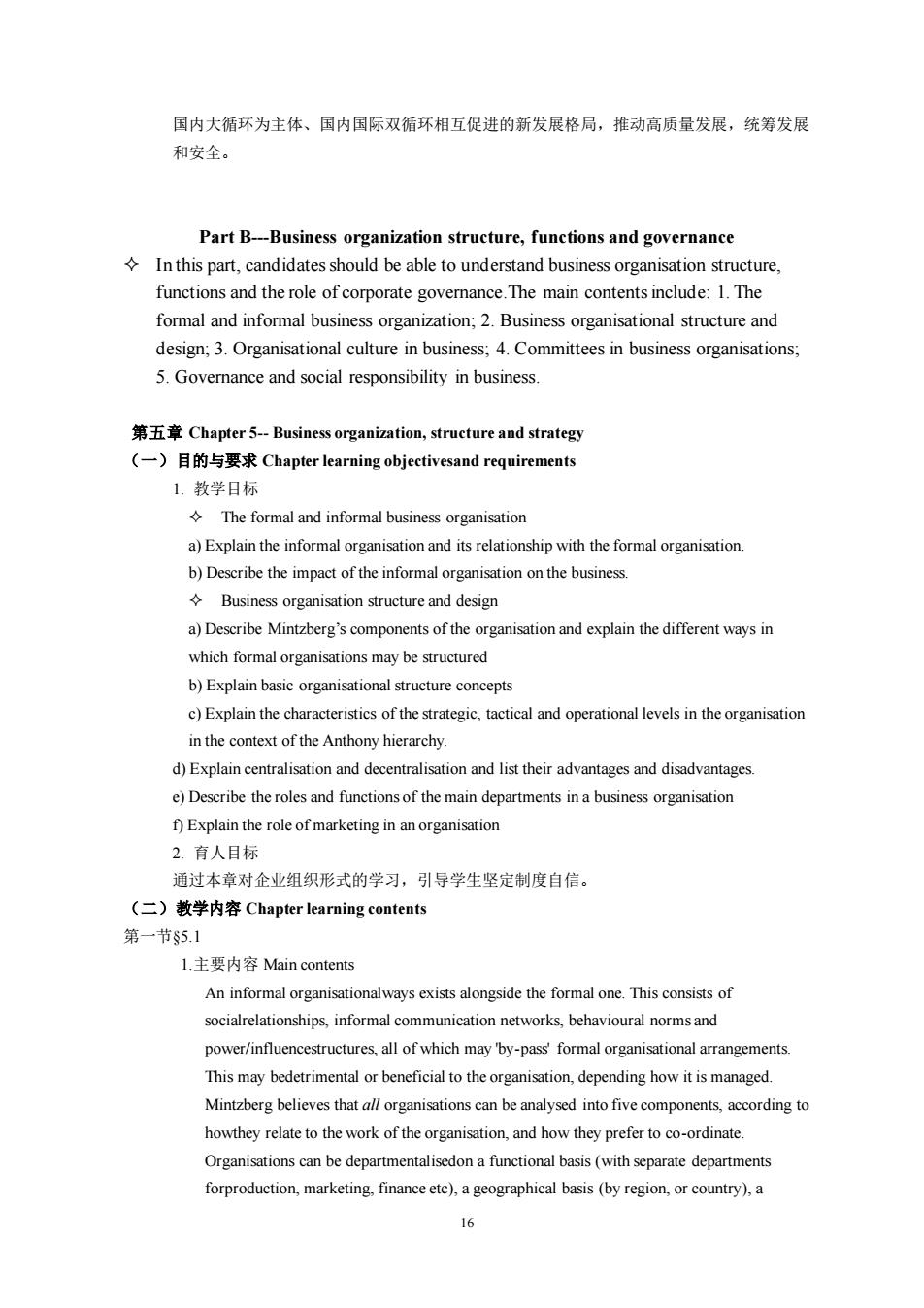
国内大循环为主体、国内国际双循环相互促进的新发展格局,推动高质量发展,统筹发展 和安全。 Part B--Business organization structure,functions and governance In this part,candidates should be able to understand business organisation structure, functions and the role of corporate governance.The main contents include:1.The formal and informal business organization:2.Business organisational structure and design;3.Organisational culture in business;4.Committees in business organisations 5.Governance and social responsibility in business. 第五章Chapter5-Business organization,structure and strategy (一)目的与要求Chapter learning objectivesand requirements 1.教学目标 The formal and informal business organisation a)Explain the informal organisation and its relationship with the formal organisation. b)Describe the impact of the informal organisation on the business Business organisation structure and design a)Describe Mintzberg's components of the organisation and explain the different ways in which formal organisations may be structured b)Explain basic organisational structure concepts c)Explain the characteristics of the strategic.tactical and operational levels in the organisation in the context of the Anthony hierarchy. d)Explain centralisation and decentralisation and list their advantages and disadvantages e)Describe the roles and functions of the main departments ina business organisation A Explain the role of marketing in an organisation 2.有人目标 通过本章对企业组织形式的学习,引导学生坚定制度自信 (二)教学内容Chapter learning contents 第一节$51 I,主要内容Main contents An informal organisationalways exists alongside the formal one.This consists of socialrelationships.informal communication networks.behavioural norms and power/of which may by-passformalorganisio arrangements This may bedetrimental or beneficial to the organisation.depending how it is managed. Mintzberg believes analysed into five components,ccordingt howthey relate to the work of the organisation,and how they prefer to co-ordinate. Organisations can be departmentalisedona functional basis(with separate departments forproduction,marketing.finance etc),a geographical basis(by region,or country).a 16
16 国内大循环为主体、国内国际双循环相互促进的新发展格局,推动高质量发展,统筹发展 和安全。 Part B---Business organization structure, functions and governance In this part, candidates should be able to understand business organisation structure, functions and the role of corporate governance.The main contents include: 1. The formal and informal business organization; 2. Business organisational structure and design; 3. Organisational culture in business; 4. Committees in business organisations; 5. Governance and social responsibility in business. 第五章 Chapter 5-- Business organization, structure and strategy (一)目的与要求 Chapter learning objectivesand requirements 1. 教学目标 The formal and informal business organisation a) Explain the informal organisation and its relationship with the formal organisation. b) Describe the impact of the informal organisation on the business. Business organisation structure and design a) Describe Mintzberg’s components of the organisation and explain the different ways in which formal organisations may be structured b) Explain basic organisational structure concepts c) Explain the characteristics of the strategic, tactical and operational levels in the organisation in the context of the Anthony hierarchy. d) Explain centralisation and decentralisation and list their advantages and disadvantages. e) Describe the roles and functions of the main departments in a business organisation f) Explain the role of marketing in an organisation 2. 育人目标 通过本章对企业组织形式的学习,引导学生坚定制度自信。 (二)教学内容 Chapter learning contents 第一节§5.1 1.主要内容 Main contents An informal organisationalways exists alongside the formal one. This consists of socialrelationships, informal communication networks, behavioural norms and power/influencestructures, all of which may 'by-pass' formal organisational arrangements. This may bedetrimental or beneficial to the organisation, depending how it is managed. Mintzberg believes that all organisations can be analysed into five components, according to howthey relate to the work of the organisation, and how they prefer to co-ordinate. Organisations can be departmentalisedon a functional basis (with separate departments forproduction, marketing, finance etc), a geographical basis (by region, or country), a
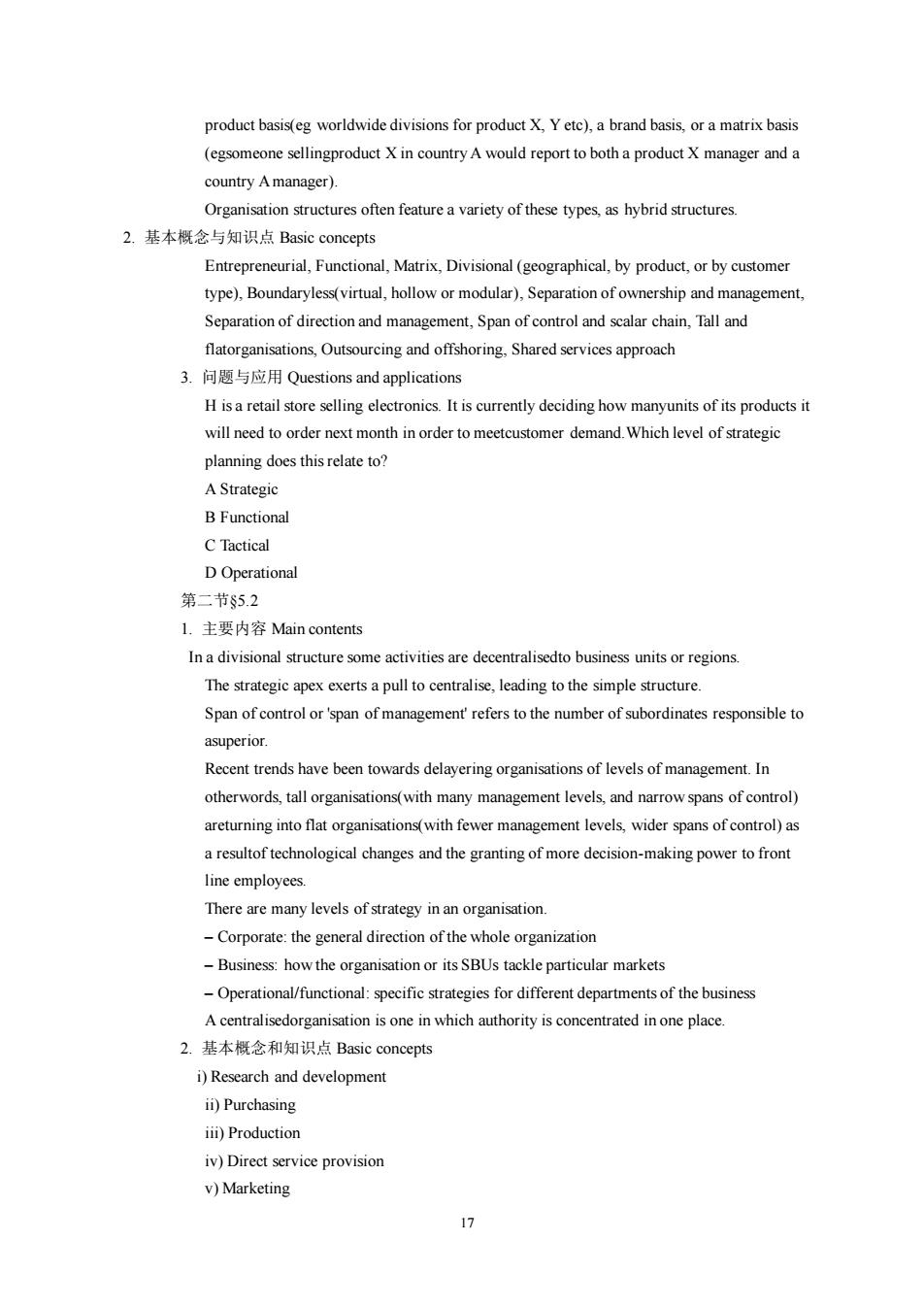
product basis(eg worldwide divisions for productYete).a brand basis,oramatrix basis (egsomeone sellingproduct X in country A would report to both a product X manager and a country A manager). Organisation structures often feature a variety of these types.as hybrid structures. 2.基本概念与知识点Basic concepts Entrepreneurial.Functional.Matrix.Divisional (geographical.by product.or by customer type),Boundaryless(virtual,hollow or modular),Separation of ownership and management Separation of direction and management.Span of control and scalar chain,Tall and flatorganisations,Outsourcing and offshoring.Shared services approach 3.问题与应用Questions and applications Hisa retail store selling electronic It is currently deciding how manyunits of its productsi will need to order next month in order to meetcustomer demand.Which level of strategic planning does thisrelate to? A Strategic BFunctional C Tactical DOperational 第二节55.2 L.主要内容Main contents In a divisional structure some activities are decentralisedto business units or regions The strategic apex exerts a pull to centralise,leading to the simple structure. Span of controlor'span of management refers to the number of subordinates responsible to asuperior. Recent trends have been towards delayering organisations of levels of management.In otherwords,tall organisations(with many management levels,and narrow spans of control) areturning into flat organisations(with fewer management levels,wider spans of)as a resultof technological changes and the granting of more decision-making power to front line employees. There are many levels of strategy in an organisation. -Corporate:the general direction of the whole organization -Business:how the organisation or its SBUs tackle particular markets -Operational/functional:specific strategies for different departments of the busines A centralisedorganisation is one in which authority is concentrated in one place 2.基本概念和知识点Basic concepts i)Research and development ii)Purchasing iii)Production iv)Direct service provision v))Marketing 17
17 product basis(eg worldwide divisions for product X, Y etc), a brand basis, or a matrix basis (egsomeone sellingproduct X in country A would report to both a product X manager and a country A manager). Organisation structures often feature a variety of these types, as hybrid structures. 2. 基本概念与知识点 Basic concepts Entrepreneurial, Functional, Matrix, Divisional (geographical, by product, or by customer type), Boundaryless(virtual, hollow or modular), Separation of ownership and management, Separation of direction and management, Span of control and scalar chain, Tall and flatorganisations, Outsourcing and offshoring, Shared services approach 3. 问题与应用 Questions and applications H is a retail store selling electronics. It is currently deciding how manyunits of its products it will need to order next month in order to meetcustomer demand.Which level of strategic planning does this relate to? A Strategic B Functional C Tactical D Operational 第二节§5.2 1. 主要内容 Main contents In a divisional structure some activities are decentralisedto business units or regions. The strategic apex exerts a pull to centralise, leading to the simple structure. Span of control or 'span of management' refers to the number of subordinates responsible to asuperior. Recent trends have been towards delayering organisations of levels of management. In otherwords, tall organisations(with many management levels, and narrow spans of control) areturning into flat organisations(with fewer management levels, wider spans of control) as a resultof technological changes and the granting of more decision-making power to front line employees. There are many levels of strategy in an organisation. – Corporate: the general direction of the whole organization – Business: how the organisation or its SBUs tackle particular markets – Operational/functional: specific strategies for different departments of the business A centralisedorganisation is one in which authority is concentrated in one place. 2. 基本概念和知识点 Basic concepts i) Research and development ii) Purchasing iii) Production iv) Direct service provision v) Marketing
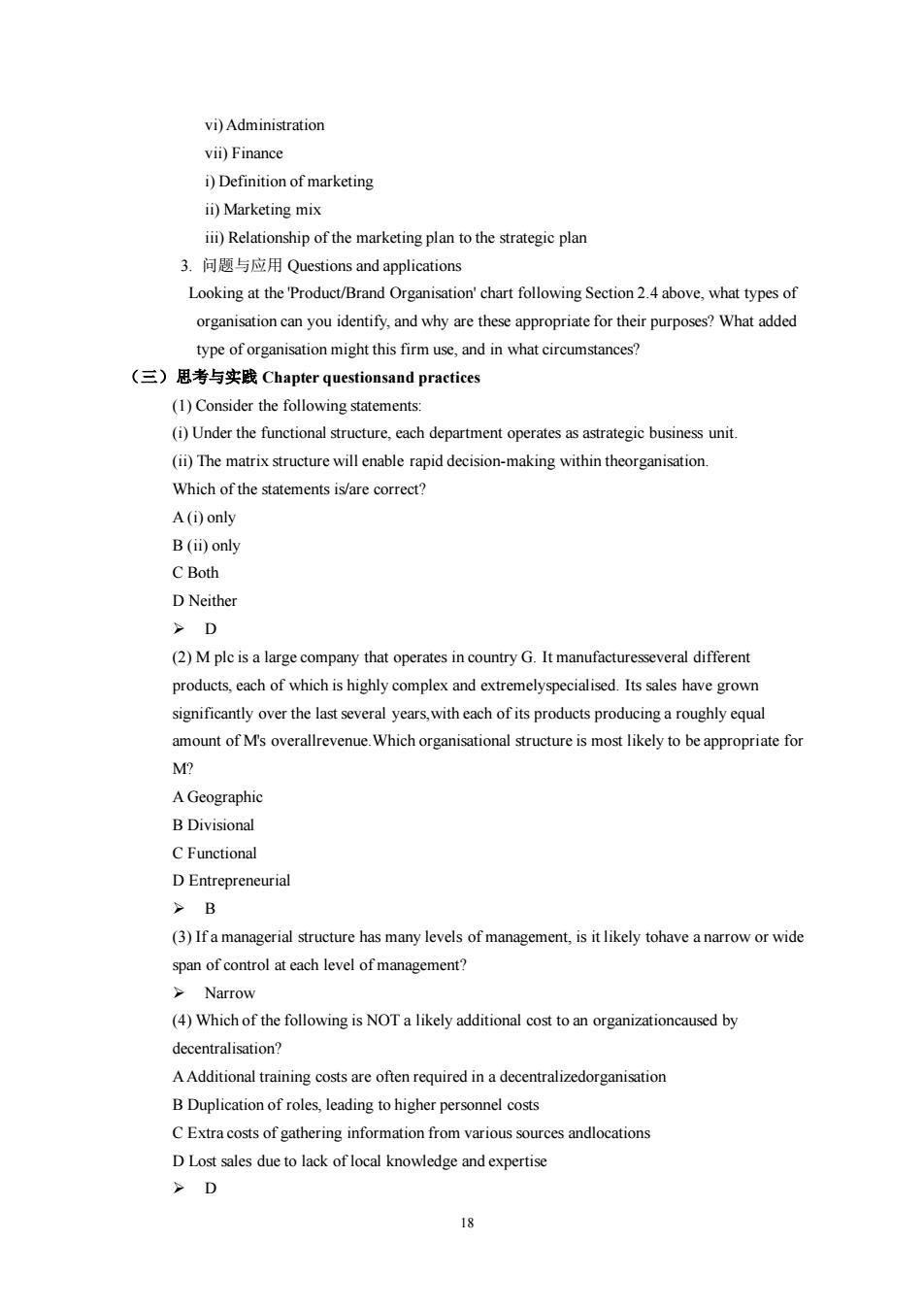
vi)Administration vii)Finance i)Definition of marketing ii)Marketing mix )Relationship of the marketing plan to the strategic plan 3.问题与应用Questions and applications Looking at the Product/Brand Organisation'chart following Section2.above,what types of organisation can you identify,and why are these appropriate for their purposes?What added type of organisation might this,and in what circumstances? (三)思考与实践Chapter questionsand practices (1)Consider the following statements (i)Under the functional structure.each department operates as astrategic business unit. (The matrx truture ill enabe rapid decision-makingwithnhrso Which of the statements is/are correct? A(i)only B(ii)only CBoth DNeither D (2)M ple is a large company that operates in country G.It manufacturesseveral different products,ach of which is highly complexand extremelyspecialised.Its sales have grown significantly over the last several vears with each of its products producing a roughly equal amount of Ms overallrevenue.Which organisational structure is most likely to be appropriate for M? A Geographic B Divisional C Functional d Entrepreneurial >B (3)Ifa managerial structure has many levels of management,is it likely tohave anarrow or wide span of control at each level of management? >Narrow (4)Which of the following is NOT a likely additional cost to an organizationcaused by decentralisa A Additional training costs are often required in a decentralizedorganisation BDuplication of roles,leading to higher personnel cost C Extra costs of gathering information from various sources andlocations DLost sales due to lack of local knowledge and expertise D 18
18 vi) Administration vii) Finance i) Definition of marketing ii) Marketing mix iii) Relationship of the marketing plan to the strategic plan 3. 问题与应用 Questions and applications Looking at the 'Product/Brand Organisation' chart following Section 2.4 above, what types of organisation can you identify, and why are these appropriate for their purposes? What added type of organisation might this firm use, and in what circumstances? (三)思考与实践 Chapter questionsand practices (1) Consider the following statements: (i) Under the functional structure, each department operates as astrategic business unit. (ii) The matrix structure will enable rapid decision-making within theorganisation. Which of the statements is/are correct? A (i) only B (ii) only C Both D Neither ➢ D (2) M plc is a large company that operates in country G. It manufacturesseveral different products, each of which is highly complex and extremelyspecialised. Its sales have grown significantly over the last several years,with each of its products producing a roughly equal amount of M's overallrevenue.Which organisational structure is most likely to be appropriate for M? A Geographic B Divisional C Functional D Entrepreneurial ➢ B (3) If a managerial structure has many levels of management, is it likely tohave a narrow or wide span of control at each level of management? ➢ Narrow (4) Which of the following is NOT a likely additional cost to an organizationcaused by decentralisation? A Additional training costs are often required in a decentralizedorganisation B Duplication of roles, leading to higher personnel costs C Extra costs of gathering information from various sources andlocations D Lost sales due to lack of local knowledge and expertise ➢ D
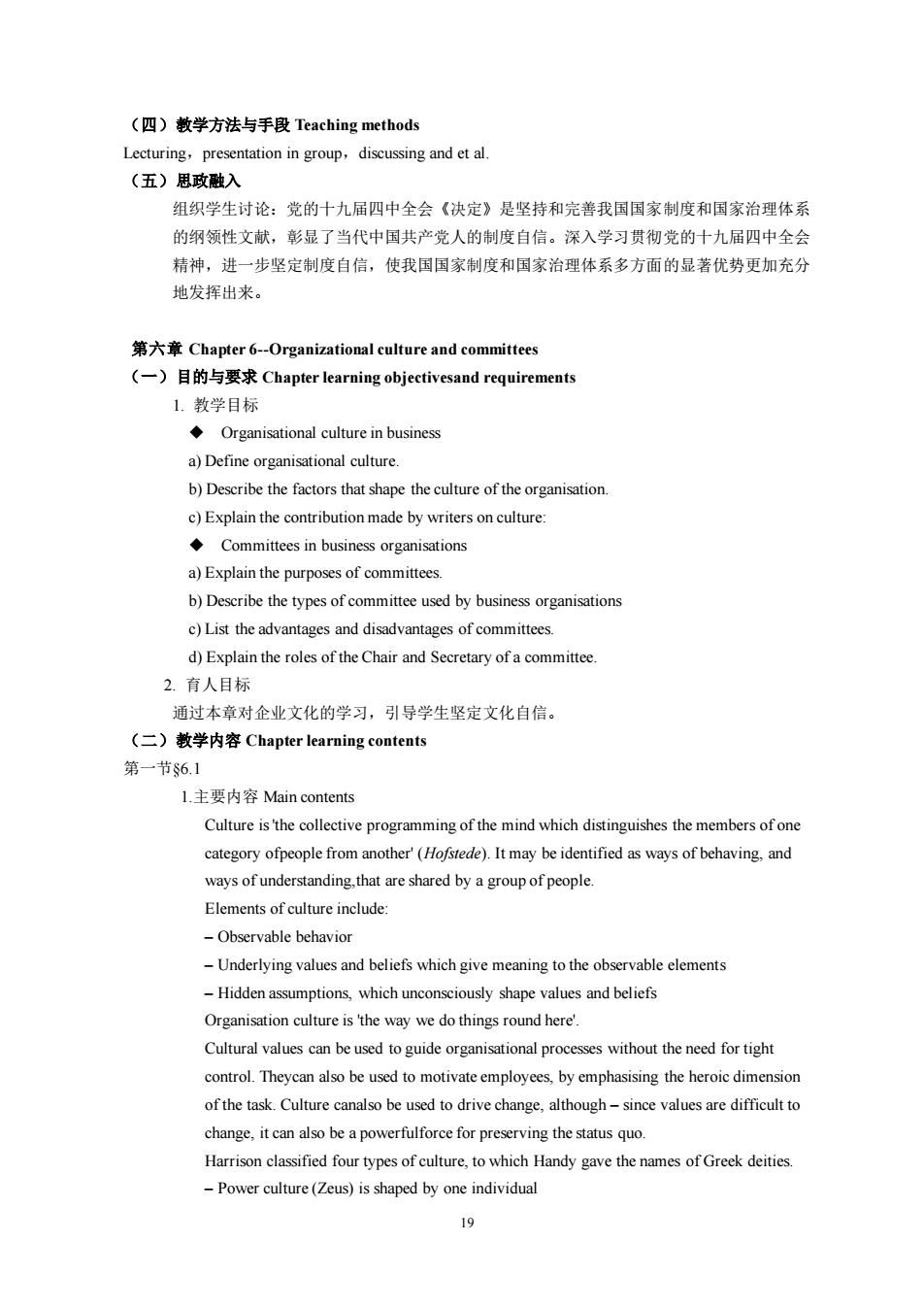
(四)教学方法与手段Teaching methods Lecturing,presentation in group,discussing and et al. (五)思政融入 组织学生讨论:党的十九届四中全会《决定》是坚持和完善我国国家制度和国家治理体系 的纲领性文献,彰显了当代中国共产党人的制度自信。深入学习贯彻党的十九届四中全会 精神,进一步坚定制度自信,使我国国家制度和国家治理体系多方面的显著优势更加充分 地发挥出来 第大章Chapter6-Organizational committees (一)目的与要求Chapter learning objectivesand requirements 1.教学目标 Organisational culture in business a)Define organisationl culture b)Describe the factors that shape the culture of the organisation. c)Explain the contribution made by Committees in business organisations a)Explain the purposes of committees b)Describe the types of committee used by business organisations )List the advantages and disadvantages of committees d)Explain the roles of the Chair and Secretary of a committee 2.有人目标 通过本章对企业文化的学习,引导学生坚定文化自信。 (二)教学内容Chapter learning contents 第一节86.1 l.主要内容Main contents Culture is'the collective programming of the mind which distinguishes the members ofo category ofpeople from another'(Hofstede).It may be identified as ways of behaving.and ways ofunderstanding.that are shared by a group of people. Elements of culture include -Observable behavior -Underlying values and beliefs which give meaning to the observable elements -Hidden assumptions,which unconsciously shape values and beliefs Organisation culture is the way we do things round here' Cultural values can be used to guide organisational processes without the need for tight control.Theycan also be used to motivate employees,by emphasising the heroic dimension ofthe task Culture c be used to drive change.althoug-since change,it can also be a powerfulforce for preserving the status quo Harrison classified four types of cuture,to which Handy gave the names of Greek deities Power culture (Zeus)is shaped by one individual 19
19 (四)教学方法与手段 Teaching methods Lecturing,presentation in group,discussing and et al. (五)思政融入 组织学生讨论:党的十九届四中全会《决定》是坚持和完善我国国家制度和国家治理体系 的纲领性文献,彰显了当代中国共产党人的制度自信。深入学习贯彻党的十九届四中全会 精神,进一步坚定制度自信,使我国国家制度和国家治理体系多方面的显著优势更加充分 地发挥出来。 第六章 Chapter 6--Organizational culture and committees (一)目的与要求 Chapter learning objectivesand requirements 1. 教学目标 ◆ Organisational culture in business a) Define organisational culture. b) Describe the factors that shape the culture of the organisation. c) Explain the contribution made by writers on culture: ◆ Committees in business organisations a) Explain the purposes of committees. b) Describe the types of committee used by business organisations c) List the advantages and disadvantages of committees. d) Explain the roles of the Chair and Secretary of a committee. 2. 育人目标 通过本章对企业文化的学习,引导学生坚定文化自信。 (二)教学内容 Chapter learning contents 第一节§6.1 1.主要内容 Main contents Culture is 'the collective programming of the mind which distinguishes the members of one category ofpeople from another' (Hofstede). It may be identified as ways of behaving, and ways of understanding,that are shared by a group of people. Elements of culture include: – Observable behavior – Underlying values and beliefs which give meaning to the observable elements – Hidden assumptions, which unconsciously shape values and beliefs Organisation culture is 'the way we do things round here'. Cultural values can be used to guide organisational processes without the need for tight control. Theycan also be used to motivate employees, by emphasising the heroic dimension of the task. Culture canalso be used to drive change, although – since values are difficult to change, it can also be a powerfulforce for preserving the status quo. Harrison classified four types of culture, to which Handy gave the names of Greek deities. – Power culture (Zeus) is shaped by one individual
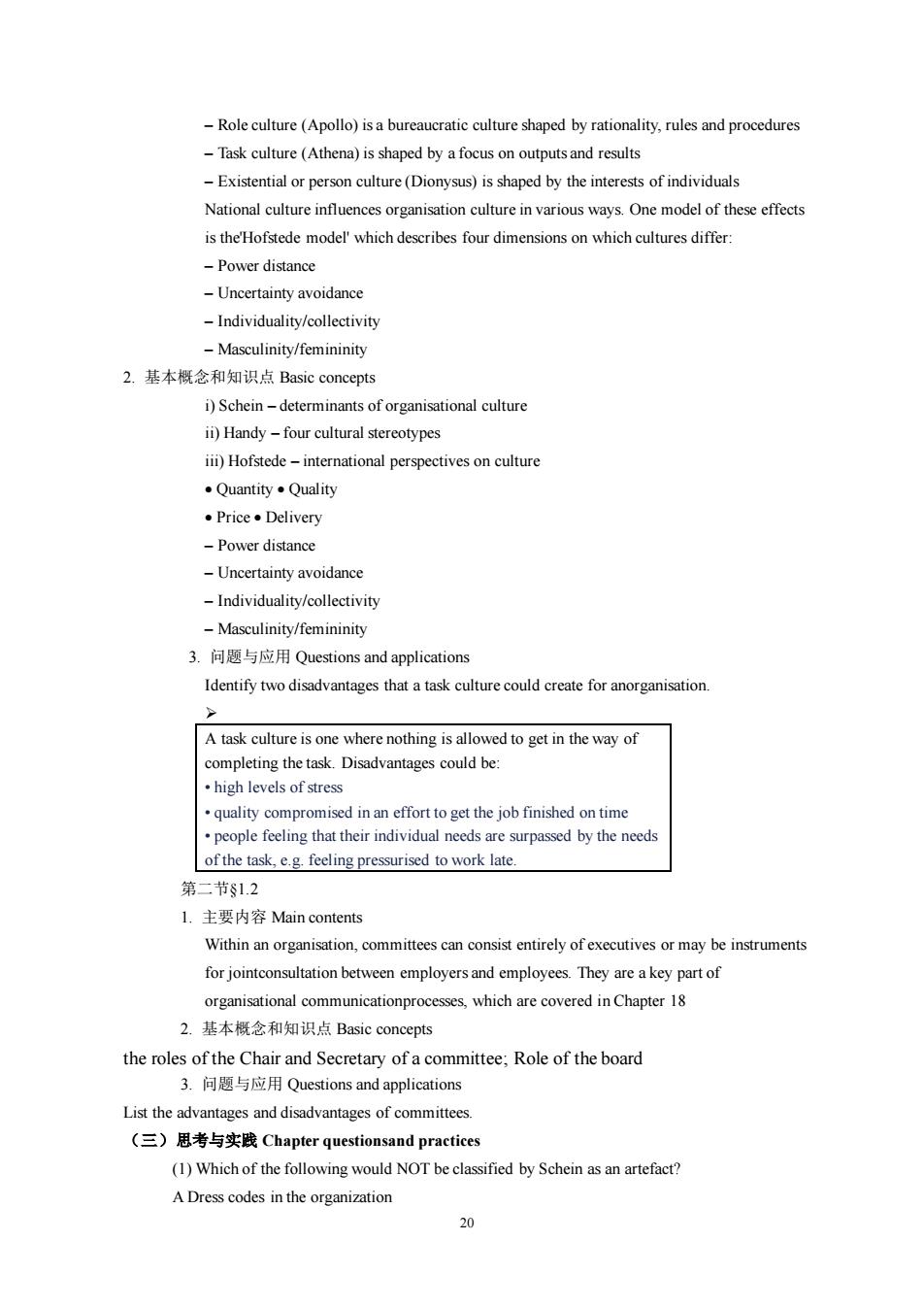
-Role culture (Apollo)isa bureaucratic culture shaped by rationality.rules and procedures -Task culture(Athena)is shaped by afocus on outputs and results -Existential or person culture(Dionysus)is shaped by the interests of individuals National culture influences organisation culture in various ways.One model of these effects is theHofstede model'which describes four dimensions on which cultures differ. Power distance -Uncertainty avoidance Individuality/collectivity -Masculinity/femininity 2.基本概念和知识点Basic concepts i)Schein-determinants of organisational culture ii)Handy -four cultural stereotypes )Hofstede-international perspectiveson cuture ·Quantity·Quality .PriceDelivery Power distance -Uncertainty avoidance -Individuality/collectivity -Masculinity/femininity 3.问题与应用Questions and applications Identify two disadvantages that a task culture coud create for anorganisation A task culture is one where nothing is allowed to get in the wayo completing the task.Disadvantages coud be high levels of stress quality compromised in an effort to get the job finished on time people feeling that their individual needs are surpassed by the needs of the task.e.g feeling pressurised to work late 第二节$12 L.主要内容Main contents Within an organisation,committees can consist entirely of executives or may be instruments for employers and They are akey part of organisational communicationprocesses.which are covered in Chapter 18 2.基本概念和知识点Basic concepts the roles of the Chair and Secretary ofa committee:Role of the board 3.问题与应用applications List the advantages and disadvantages of committees. (三)思考与实践Chapter questionsand practices (1)Which of the following would NOT be classified by Schein as an artefact? A Dress codes in the organization 20
20 – Role culture (Apollo) is a bureaucratic culture shaped by rationality, rules and procedures – Task culture (Athena) is shaped by a focus on outputs and results – Existential or person culture (Dionysus) is shaped by the interests of individuals National culture influences organisation culture in various ways. One model of these effects is the'Hofstede model' which describes four dimensions on which cultures differ: – Power distance – Uncertainty avoidance – Individuality/collectivity – Masculinity/femininity 2. 基本概念和知识点 Basic concepts i) Schein – determinants of organisational culture ii) Handy – four cultural stereotypes iii) Hofstede – international perspectives on culture • Quantity • Quality • Price • Delivery – Power distance – Uncertainty avoidance – Individuality/collectivity – Masculinity/femininity 3. 问题与应用 Questions and applications Identify two disadvantages that a task culture could create for anorganisation. ➢ A task culture is one where nothing is allowed to get in the way of completing the task. Disadvantages could be: • high levels of stress • quality compromised in an effort to get the job finished on time • people feeling that their individual needs are surpassed by the needs of the task, e.g. feeling pressurised to work late. 第二节§1.2 1. 主要内容 Main contents Within an organisation, committees can consist entirely of executives or may be instruments for jointconsultation between employers and employees. They are a key part of organisational communicationprocesses, which are covered in Chapter 18 2. 基本概念和知识点 Basic concepts the roles of the Chair and Secretary of a committee; Role of the board 3. 问题与应用 Questions and applications List the advantages and disadvantages of committees. (三)思考与实践 Chapter questionsand practices (1) Which of the following would NOT be classified by Schein as an artefact? A Dress codes in the organization